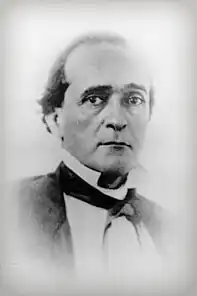Harris Flanagin | |
|---|---|
 | |
| 7th Governor of Arkansas | |
| In office November 15, 1862 – April 18, 1864 In exile April 18, 1864 – June 1, 1865[lower-alpha 1] | |
| Preceded by | Thomas Fletcher (acting) |
| Succeeded by | Isaac Murphy |
| Member of the Arkansas Senate from Ouachita and Clark counties | |
| In office November 6, 1848 – November 4, 1850 | |
| Preceded by | B. W. Pearce |
| Succeeded by | Constituency abolished |
| Member of the Arkansas House of Representatives from Clark County | |
| In office November 7, 1842 – November 4, 1844 Serving with Joshua D. Stewart | |
| Preceded by | Simeon Buckner Archibald H. Rutherford |
| Succeeded by | Joseph Gray William Owens |
| Personal details | |
| Born | November 3, 1817 Roadstown, New Jersey, U.S. |
| Died | October 23, 1874 (aged 56) Arkadelphia, Arkansas, U.S. |
| Resting place | Rose Hill Cemetery, Arkadelphia, Arkansas, U.S. 34°7′8.3″N 93°3′42.6″W / 34.118972°N 93.061833°W |
| Political party | Democratic (from 1856) |
| Other political affiliations | Whig (until 1856) |
| Spouse |
Martha Eliza Flanagin
(m. 1851) |
| Children | 3 |
| Military service | |
| Allegiance | Confederate States |
| Branch | Army |
| Years of service | 1861–1862 |
| Rank | Colonel |
| Commands | 2nd Arkansas Mounted Rifles |
| Battles | |
Harris Flanagin (November 3, 1817 – October 23, 1874) was an American politician and lawyer who served as the 7th governor of Arkansas from 1862 to 1864, and in exile from 1864 to 1865. Prior to this he was a Confederate States Army officer who commanded infantry in the Western Theater of the American Civil War.
Early life and education
Flanagin was born in the Roadstown section of Hopewell Township, Cumberland County, New Jersey, to James, a farmer and cabinetmaker, and Mary (née Harris) Flanagin. He was educated at a Quaker school in New Jersey and then went on to teach at Clermont Seminary in Frankford (present-day Philadelphia). Soon after he moved to Illinois, where he again tried teaching and while at this work studied law.[2] In 1838 Flanagin moved to Arkansas, settling first at Pine Bluff, then Little Rock, then Clark County in 1839, and Arkadelphia in 1842. He served in the Arkansas House of Representatives from 1842 to 1844 and the Arkansas Senate from 1848 to 1850. He was married on July 3, 1851, to Miss Martha Eliza Nash of Lafayette County.[3] During the American Civil War Flanagin was promoted to colonel,[4] commanding the 2nd Arkansas Mounted Rifles.[5]
Governor of Arkansas
In 1862, Flanagin was elected governor of Arkansas and resigned from the Army to take office.[6] His administration dealt primarily with war related measures and maintaining order and continuing government while undergoing an invasion. The government was faced with shortages of critical items, rising prices, care of fallen soldier's families, and related problems. During the American Civil War, the state government was forced to suspend the collection of taxes and financed the war with paper "war bonds".[3] When on September 10, 1863, the capital of Little Rock fell to Union forces and Arkansas's state government fled the city, he seized as many government documents as he could and reestablished the capital at Washington, Arkansas. While governor Flanagin remained in Confederate controlled southwest Arkansas, a Union administration under provisional governor Isaac Murphy was inaugurated April 18, 1864, in the Arkansas State House at Little Rock.
Later life and death
After the American Civil War, Flanagin returned the state archives and resumed his law practice in Arkadelphia. He died and is buried at Rose Hill Cemetery, Arkadelphia.[7]
Electoral history
| Party | Candidate | Votes | % | |
|---|---|---|---|---|
| Independent | Harris Flanagin | 18,139 | 69.06 | |
| Independent Democrat | Henry M. Rector (incumbent) | 7,419 | 28.25 | |
| Independent | John S. H. Rainey | 708 | 2.7 | |
| Total votes | 26,266 | 100.0 | ||
See also
Notes
- ↑ Flanagin's last official act as governor was to preside over the Arkansas Military Board during its final meeting at Washington, Arkansas, on June 1, 1865;[1] six days after the Trans-Mississippi Department was surrendered to U.S. authorities at New Orleans.
References
- ↑ Minute Book of the Military Board of Arkansas, 1862-1865. Washington, Arkansas. p. 228.
- ↑ "Harris Flanagin". National Governors Association. January 15, 2019. Retrieved March 29, 2020.
- 1 2 Newberry, Farrar. "Harris Flanagin." Arkansas Historical Quarterly 17 (Spring 1955): 3–20.
- ↑ Evans, Clement A., ed. (1899). Confederate Military History. Vol. I. Atlanta, Ga.: Confederate Pub. Co. p. 718. LCCN 02017198. OCLC 951143. OL 7023000M – via Internet Archive.
- ↑ Evans, Clement A., ed. (1899). Confederate Military History. Vol. X. Atlanta, Ga.: Confederate Pub. Co. p. 285. LCCN 02017198 – via Internet Archive.
- ↑ Yearns, W. Buck, ed. (1985). The Confederate Governors. Athens: University of Georgia Press. ISBN 082030719X. LCCN 84000154. OL 2838407M – via Internet Archive.
- ↑ Dougan, Michael B. (April 25, 2018). "Harris Flanagin (1817–1874)". Encyclopedia of Arkansas. Central Arkansas Library System.
- ↑ Hodges, Earle W. (1913). Arkansas Biennial Report of the Secretary of State. Little Rock: Tunnah & Pittard. p. 104.
- ↑ Historical Report of the Secretary of State, 2008. Designed by Jennifer Hughes. The University of Arkansas Press. 2008. p. 620. ISBN 978-0-615-23214-0. OCLC 1193944261 – via Internet Archive.
{{cite book}}: CS1 maint: others (link)
